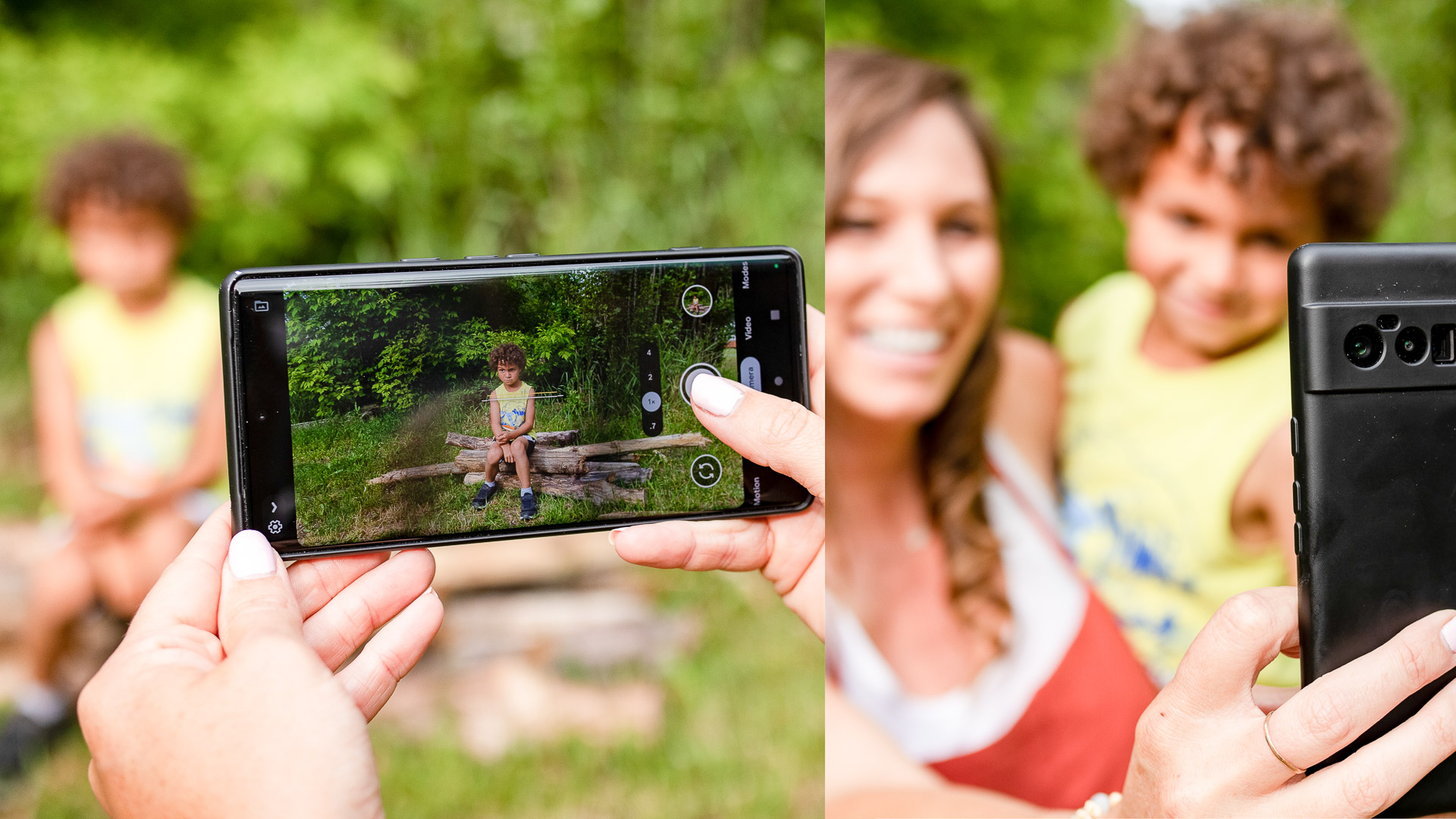
Summer adventures are right around the corner, which hopefully means you have some fun things planned for your family! Whether you’re hiking, biking, boating, road tripping, camping or just heading to a new town, you will most likely want to capture a few memories along the way. Of course, these memories can look a bit different for each family. You may prefer to solely take scenic photos of the places you visit, or you may love capturing your family within those amazing places. Either way, photos and videos are a great way to remember your experiences and quality family time, but they can also be a bit challenging. There are numerous challenges, like crowded attractions, difficult lighting, weather and probably the most common: Attempting to wrangle your family members together for a quick photo or video clip.
Over the years, our family has had a lot of practice documenting our memories and adventures. We have some solid tips and tricks plus helpful gear to share with you. These are especially helpful if you are not a skilled videographer or photographer, as many of us aren’t. But they will help you capture some great memories, and the best part is you can choose which tips and gear work best for your family.

Getting Your Family Interested In Photos And/Or Video
Depending on the age of your family members, it may be best to have a chat with them prior to your vacations, adventures or excursions about capturing memories. Emphasize how much fun your plans will be and how you want to have something to be able to look back on and remember. Ask their opinions on what type of photos they like to take: Scenic or people, silly or serious, smiley or candid. Possibly pull out some older photos and videos to watch and enjoy so they remember how great it is to have these memories. The goal would be to set everyone’s expectations ahead of time and possibly get your family to agree to a photo/video capture plan.
We’ve found compromising works the best for us — we take silly zombie poses for our son and then smile pictures for us. We also usually divide and conquer, where one of us will focus on video memories while the other captures the photos. It may take trying a few things to figure out your family’s rhythm, but stick with it — they will thank you for it later!

Using Your Cellphone Camera
Using your cellphone to document family photos and videos is the quickest and most convenient option while out adventuring. Cellphones today are built to be minicomputers with really good cameras. If you have a newer phone, you most likely have ideal features like timers, light settings, file format options and multiple zoom options. If you are not familiar with these on your phone, a quick YouTube search should help you. Once you are familiar with taking photos and videos on your phone, a few important tips to note are: 1) Make sure you have plenty of storage space on your phone prior to your vacations or excursions and 2) Have content backup set up, whether it’s to the Cloud, Google Photos or some other format. The last thing you want to happen is having to delete a bunch of photos just to take more … trust us! And always having your content backed up is huge in case something happens to your phone along the way. You want to make sure your memories are preserved elsewhere, too.
One of the tricky parts about using your cellphone as a camera is trying to capture all of you in the photo. To help with that, there are plenty of inexpensive attachments available. The selfie stick was popular for some time, and we still use one from time to time. We do, however, prefer to use a tripod with the self-timer mode. If you don’t have either of these tools, you can prop your phone on a rock or tree stump and use the self-timer mode. And, of course, you can also ask someone nearby to take a photo for you.

Handheld Cameras
There are so many types of cameras and brands on the market, it can be overwhelming figuring out what camera is best for your family. The two main types are point-and-shoot, which is perfect for just getting started, and then DSLR and mirrorless cameras, which give you more image control than a point-and-shoot as well as the option to switch your lens. If you choose to use a handheld camera, be sure to have a large-capacity SD card and extra batteries. We typically charge our batteries each night and always bring more with us. You’ll want to get to know your camera and settings. Again, a quick YouTube video can help with this. And most likely your camera will have an “auto” mode. It works in a pinch or if you won’t be editing your photos. But with some basic photography knowledge, you can take photos that you can edit later to get the exact look you want.
We tend to use both our phones and handheld cameras. Our phones are primarily used for capturing quick moments and sharing our adventures on social media. Our handheld camera is used for scenic photos, family photos in epic locations and when we want to take really high-quality RAW images to be used for future editing and printing.

Action Cameras (GoPro)
If your vacations and family trips include a lot of adventure, especially on the water, an action camera (we use GoPro) is definitely a great option to consider. They are specifically made to capture epic memories that normal cameras can’t. And they are also impact-resistant and waterproof. While GoPros are mainly designed to capture videos, they can also take pretty, high-quality photos. And the quality of the videos is so good that you can often take a screen-grab photo from your video clips.
GoPro offers you so many features, like slow motion and time lapse, to create cool videos even if you are just learning how. Additionally, it offers a bunch of accessories, like tripods, hands-free mounts for helmets, bikes, boats, paddleboards, your body and so much more.
We had two GoPro 8s that we film almost exclusively with and love the memories we are able to capture. If you are using your GoPro in or around the water, be sure to have it securely attached to something nearby or a really good flotation device. While they are waterproof, they do not float — trust us! We just lost one of ours in the Colorado River in Utah.

Water Protective Gear
The summer months are pretty synonymous with hot temperatures and lots of water fun. Be it kayaking on a river, paddling a beautiful lake, wakeboarding, taking on some whitewater, deep sea fishing or enjoying a water park, all of these experiences are a blast and should definitely be documented. So, you will want to make sure you have the proper water protective gear for your cameras and phones.
When out on the water, we typically use a dry bag to keep our larger gear in and waterproof floating cases that attach around our neck for our cellphones. If in a bind, a ziplock bag or two can work great as well. A benefit to the waterproof floating cellphone holders is that you can still take photos and videos without having to remove your phone from the holder. Be sure to lash your dry bags down securely!

Drone
If you are going to one of your favorite bucket list places with incredible views, a drone might be exactly what you need to create some phenomenal captured memories. Not only are drones fun to fly, they can capture views from up to 400 feet in the air! As long as you are in a permitted drone area, most drones can easily fly over water, roads and mountains. With cool features like “follow me,” they can automatically follow you, your vehicle, boat, kayak or paddleboard.
Drone footage is some of our favorite content because we get to see a bird’s-eye view of where we are and what we are doing. As cool as that is, there can be challenges, too. We highly recommend having a protection plan on your drone (DJI offers this on its products). You’ll also want to get some extra batteries. Drones can fly for up to 30 minutes, and it’s easy to get carried away in capturing the moments. Thankfully, many of the drones have built-in technology to return to you prior to the battery dying.
ALWAYS be aware of local drone laws and regulations in the area you want to fly. One major thing to note is that you are not allowed to fly drones in national parks or sites. Be sure to research drone-flying rules ahead of time to avoid hefty fines.

Helpful Accessories
Whether you are heading out on your adventures with a cellphone, camera, GoPro or all of the above, we have a few “nice to have” accessories to recommend. First is a handheld tripod. Many handheld tripods offer several features to be used as a tripod or a longer stick to give you additional flexibility in capturing moments on the move. We also use a full-size compact tripod regularly for photos and to document candid video moments. Be sure to have mounts and adapters for cellphones, cameras and GoPros. And lastly, a handheld shutter remote. As we mentioned before, your cellphone most likely has a built-in timer but only offers you up to 10 seconds to be ready for the photo. A shutter remote connects via Bluetooth to your cellphone or camera and then takes the photo by clicking the remote button. They are small and can easily be concealed in your hand, to not be seen in your photo.
We hope you have an amazing summer ahead and found some of these tips and gear suggestions helpful when creating memories to last a lifetime!





